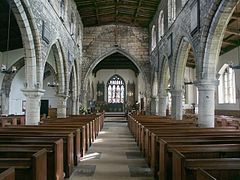Haxey
| Haxey | |
|---|---|
 Interior of St Nicholas' Church, Haxey |
|
| Haxey shown within Lincolnshire | |
| Population | 4,584 (2011 Census) |
| OS grid reference | SK765995 |
| • London | 130 mi (210 km) S |
| Unitary authority | |
| Ceremonial county | |
| Region | |
| Country | England |
| Sovereign state | United Kingdom |
| Post town | DONCASTER |
| Postcode district | DN9 |
| Dialling code | 01427 |
| Police | Humberside |
| Fire | Humberside |
| Ambulance | East Midlands |
| EU Parliament | Yorkshire and the Humber |
| UK Parliament | |
Haxey is a village and civil parish within North Lincolnshire, England. It is situated approximately 22 miles (35 km) to the north-west from the city and county town of Lincoln. The 2001 Census recorded a Haxey total resident population of 4,359 (including East Lound and Westwoodside), increasing to 4,584 at the 2011 census.
The village of Haxey lies between the villages of Westwoodside and Owston Ferry, forms part of the Isle of Axholme, and is perhaps most notable for Haxey Hood; a local event with over 700 years of history, reputedly making it "Britain’s oldest traditional tussle".
Haxey is situated on one of a series of low-lying hills which reach a maximum height of 133 feet (41 m) out of the surrounding marshland. The River Trent lies to the east, beyond Owston Ferry.
The civil parish of Haxey includes the villages of Haxey and Westwoodside, and the hamlets of High Burnham (the highest elevation of the Isle of Axholme), Low Burnham, East Lound and Graizelound.
Haxey, previously the 'capital' of the Isle of Axholme, was considerably destroyed by fire in 1741.
The village Grade I listed Anglican parish church, dedicated to St Nicholas, originates from the 12th and 13th century. It is of mainly Perpendicular Gothic style. The tower is of three stages, with an embattled parapet. Piers of the north arcade are Norman, and those of the south, with the chancel arch and chantry chapel, mainly Early English.
...
Wikipedia

